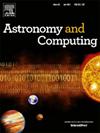Africanus IV. The Stimela2 framework: Scalable and repeatable workflows, from local to cloud compute
IF 1.8
4区 物理与天体物理
Q2 ASTRONOMY & ASTROPHYSICS
引用次数: 0
Abstract
Stimela2 is a new-generation framework for developing data reduction workflows. It is designed for radio astronomy data but can be adapted for other data processing applications. Stimela2 aims at the middle ground between ease of development, human readability, and enabling robust, scalable and repeatable workflows. Stimela2 defines a YAML-based domain specific language (DSL), which represents workflows by linear, concise and intuitive YAML-format recipes. Atomic data reduction tasks (binary executables, Python functions and code, and CASA tasks) are described by YAML-format cab definitions detailing each task’s schema (inputs and outputs). The Stimela2 DSL provides a rich syntax for chaining tasks together, and encourages a high degree of modularity: recipes may be nested into other recipes, and configuration is cleanly separated from recipe logic. Tasks can be executed natively or in isolated environments using containerization technologies such as Apptainer. The container images are open-source and maintained through a companion package called cult-cargo. This enables the development of system-agnostic and repeatable workflows. Stimela2 facilitates the deployment of scalable, distributed workflows by interfacing with the Slurm scheduler and the Kubernetes API. The latter allows workflows to be readily deployed in the cloud. Previous papers in this series used Stimela2 as the underlying technology to run workflows on the AWS cloud.
This paper presents an overview of Stimela2’s design, architecture and use in the radio astronomy context.
Stimela2框架:从本地计算到云计算,可扩展和可重复的工作流
Stimela2是用于开发数据简化工作流程的新一代框架。它是为射电天文数据设计的,但也可以适用于其他数据处理应用。Stimela2的目标是在易于开发、易于阅读和支持健壮的、可伸缩的和可重复的工作流之间的中间地带。Stimela2定义了一种基于yaml的领域特定语言(DSL),它通过线性、简洁和直观的yaml格式食谱来表示工作流。原子数据缩减任务(二进制可执行文件、Python函数和代码以及CASA任务)由详细描述每个任务模式(输入和输出)的yaml格式cab定义来描述。Stimela2 DSL为将任务链接在一起提供了丰富的语法,并鼓励高度模块化:配方可以嵌套到其他配方中,配置与配方逻辑完全分离。任务可以本地执行,也可以使用容器化技术(如Apptainer)在孤立的环境中执行。容器映像是开源的,并通过一个名为cult-cargo的配套包进行维护。这使得开发与系统无关且可重复的工作流成为可能。Stimela2通过与Slurm调度程序和Kubernetes API接口,简化了可扩展的分布式工作流的部署。后者允许在云中轻松部署工作流。本系列之前的文章使用Stimela2作为在AWS云上运行工作流的底层技术。本文概述了Stimela2的设计、结构和在射电天文学背景下的使用。
本文章由计算机程序翻译,如有差异,请以英文原文为准。
求助全文
约1分钟内获得全文
求助全文
来源期刊

Astronomy and Computing
ASTRONOMY & ASTROPHYSICSCOMPUTER SCIENCE,-COMPUTER SCIENCE, INTERDISCIPLINARY APPLICATIONS
CiteScore
4.10
自引率
8.00%
发文量
67
期刊介绍:
Astronomy and Computing is a peer-reviewed journal that focuses on the broad area between astronomy, computer science and information technology. The journal aims to publish the work of scientists and (software) engineers in all aspects of astronomical computing, including the collection, analysis, reduction, visualisation, preservation and dissemination of data, and the development of astronomical software and simulations. The journal covers applications for academic computer science techniques to astronomy, as well as novel applications of information technologies within astronomy.
 求助内容:
求助内容: 应助结果提醒方式:
应助结果提醒方式:


